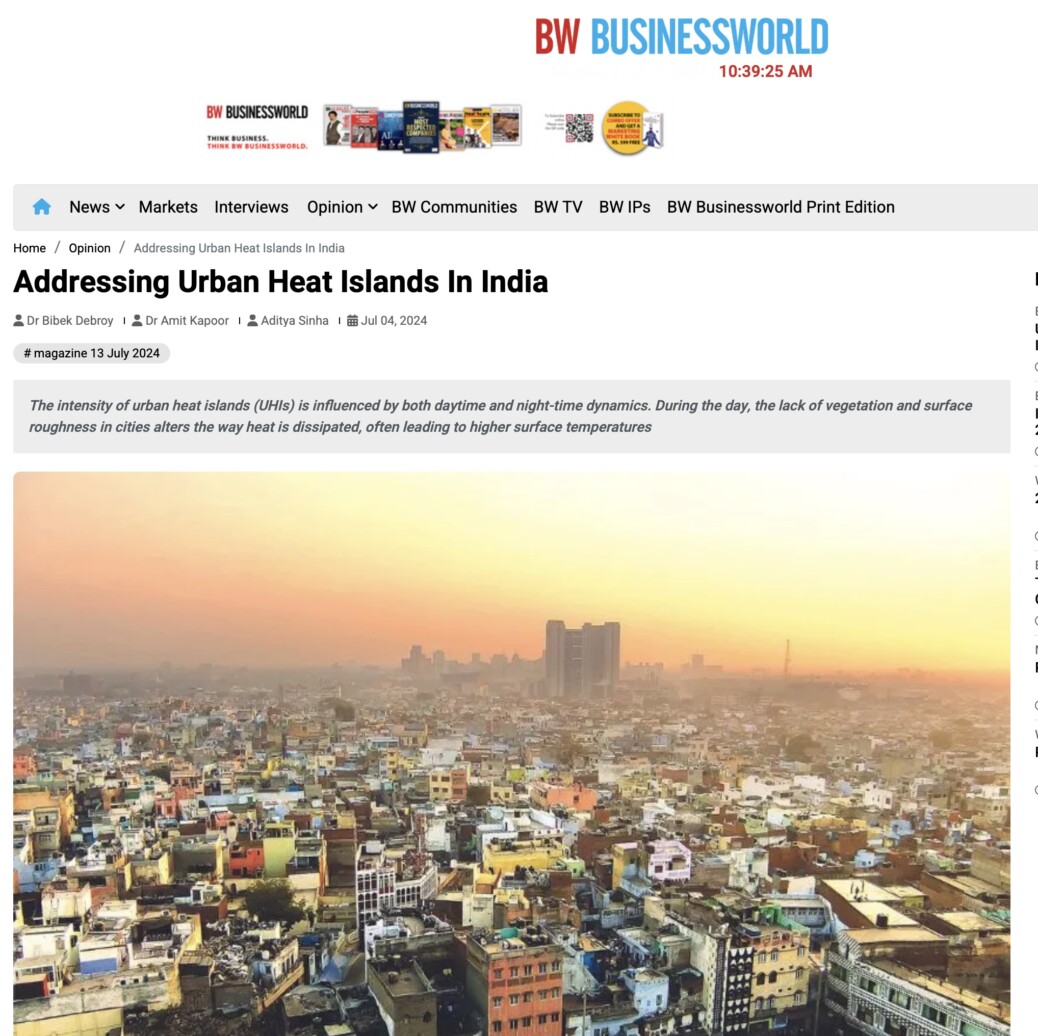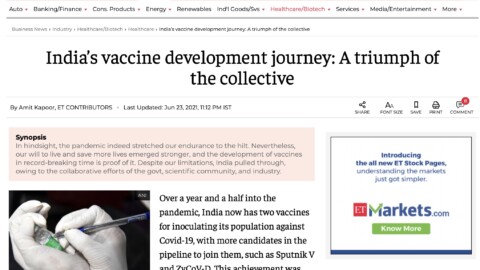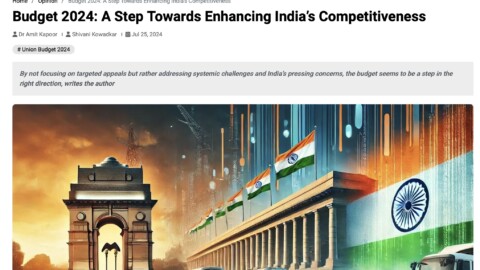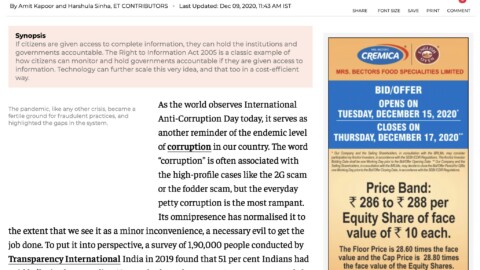By Bibek Debroy, Amit Kapoor & Aditya Sinha
In the midst of June, Delhi is sweltering under an unprecedented heat wave, setting a new record for the hottest night ever. The city’s base observatory at Safdarjung recorded a scorching minimum temperature of 35.2°C, shattering the previous high of 34.7°C from June 3, 2010. For 37 consecutive days, the national capital has endured maximum temperatures soaring above 40°C. Large parts of northern and eastern India are similarly engulfed in relentless heat, pushing power demands to unprecedented heights as warm nights compound the suffering. High nighttime temperatures pose severe risks as the body lacks the opportunity to cool down. This phenomenon is especially pronounced in urban areas due to the urban heat island effect, where cities are significantly hotter than their rural surroundings, making even the morning water from taps boiling hot.
Urban heat islands (UHIs) refer to the phenomenon where urban areas experience significantly higher temperatures compared to their rural counterparts. This temperature disparity arises due to various factors including the concentration of buildings, concrete, and asphalt which absorb and retain heat more effectively than natural landscapes. The density and geometry of urban structures, combined with the limited vegetation, reduce the natural cooling effects of wind and shade, exacerbating the heat retention. Anthropogenic activities such as vehicular emissions, industrial processes, and energy consumption further contribute to the elevated temperatures in cities. According to Manoli et al. (2019), local hydroclimatic conditions and population size are pivotal in explaining the magnitude of UHIs, highlighting that urbanization and climate interact in complex ways to influence urban temperature anomalies.
The intensity of UHIs is influenced by both daytime and nighttime dynamics. During the day, the lack of vegetation and surface roughness in cities alters the way heat is dissipated, often leading to higher surface temperatures. At night, the thermal properties of urban materials and the heat generated by human activities prevent cities from cooling down as efficiently as rural areas. Manoli et al. (2019) found that while precipitation can modulate UHI effects, its impact varies with climate; in arid regions, cities may cool more efficiently than their surroundings, whereas in humid regions, the opposite is true. Moreover, the relationship between city size and heat intensity is not straightforward, as larger cities with taller buildings might enhance heat convection, yet also face challenges in reducing heat due to increased surface roughness.
Urban green spaces, such as parks, gardens, and green roofs, are crucial for mitigating the urban heat island effect and enhancing climate resilience. Vegetation cools the air through evapotranspiration and provides shade, reducing overall urban temperatures. Bowler et al. (2010) in Landscape and Urban Planning highlight that urban parks can reduce city temperatures by up to 1-2°C. However, the efficiency of urban vegetation in reducing heat depends on background climate conditions, as vegetation may increase humidity in hot tropical regions, potentially reducing thermal comfort (Manoli et al., 2019). Sustainable Urban Drainage Systems (SUDS), including permeable pavements, rain gardens, and green roofs, manage urban stormwater, reducing flood risks and improving water quality. Fletcher et al. (2015) in Water Research emphasize the effectiveness of SUDS in mitigating flooding in urban areas, particularly in developing countries where infrastructure may be inadequate.
Improving the energy efficiency of buildings through better insulation, reflective roofing materials, and energy-efficient windows can significantly reduce energy consumption and greenhouse gas emissions. Santamouris (2014) in Energy and Buildings found that energy-efficient buildings can lower cooling demands by up to 50%, which is vital for developing nations with limited energy resources. In India, the union government’s India Cooling Action Plan (ICAP) of 2019 paints a vivid picture of India’s future cooling needs. Currently, only about 8% of households have room air conditioners, but this figure is projected to surge to 21% by 2027-28 and to a staggering 40% by 2037-38. Moreover, the stock of refrigerant-based equipment is expected to multiply tenfold over the next two decades, with room air conditioners maintaining an overwhelming 80-90% market share. This growth could be even more pronounced given the rising number of heatwave days.
Mixed-use development combines residential, commercial, and recreational spaces, reducing the need for long commutes and promoting more efficient land use. Cervero and Duncan (2006) in Urban Studies demonstrate that mixed-use neighborhoods can reduce greenhouse gas emissions by encouraging walking and cycling, important for developing countries aiming to reduce their carbon footprint. Developing efficient and affordable public transportation systems reduces reliance on private vehicles, lowering emissions and urban congestion. Buehler and Pucher (2012) in Transport Reviews indicate that cities with robust public transit systems have lower per capita emissions, a critical consideration for rapidly urbanizing areas in developing countries.
Buildings designed to respond to local climatic conditions, such as using natural ventilation, shading, and thermal mass, can significantly enhance urban climate resilience. Olgyay and Herdt (2004) in Building Research & Information highlight the benefits of climate-responsive design in reducing energy use and improving occupant comfort in hot and humid climates common in many developing countries. Community-based adaptation involves local communities in planning and implementing climate resilience strategies, ensuring solutions are culturally appropriate and widely accepted. Dodman and Mitlin (2013) in Environment and Urbanization emphasize the effectiveness of community-led initiatives in building resilience in low-income urban areas. Increasing the reflectivity (albedo) of urban surfaces through light-colored roofs and pavements can reduce heat absorption and lower urban temperatures. Akbari et al. (2009) in Climatic Change demonstrate that increasing urban albedo can mitigate the urban heat island effect and improve comfort levels, particularly in densely populated cities in developing countries.
Incorporating climate risk assessments into urban planning ensures that infrastructure and development projects are resilient to future climate impacts. Hallegatte et al. (2013) in Nature Climate Change underscore the importance of integrating climate risk into urban planning to safeguard investments and livelihoods, especially in vulnerable developing nations. Compact urban development reduces land use, lowers transportation emissions, and promotes more efficient resource use. Newman and Kenworthy (1999) in Journal of Transport and Land Use show that high-density urban areas have lower per capita energy consumption and emissions, a key strategy for sustainable urbanization in developing countries.
Climate-sensitive urban planning is essential for maximizing the benefits of urban vegetation and other climate mitigation strategies. Urban vegetation, while valuable as natural capital, may require context-specific management based on local climate conditions to avoid increasing humidity and reducing thermal comfort (Manoli et al., 2019). Detailed numerical simulations and high-resolution data are crucial for understanding city-specific interactions between climate and urban form. Urban planners should consider the site-specific urban and climate characteristics to design effective heat mitigation strategies that include maximizing shading and ventilation rather than relying solely on evaporative cooling (Manoli et al., 2019). Given that urban vegetation improves the provision of other ecosystem services, such as reduced pollution, improved health, recreation, biodiversity, shading, carbon sequestration, and water regulation, the full extent of its benefits cannot be evaluated on the basis of surface cooling alone. However, it is safe to state that heat mitigation strategies in urban environments that experience large precipitation should focus on maximizing shading and ventilation rather than evaporative cooling (Manoli et al., 2019). The aerodynamic properties of cities also help to regulate the intensity of UHIs, but the complexity and non-uniformity of urban geometries influence the exchange of heat and momentum at the land surface, requiring ongoing research, especially at scales relevant for urban design (Manoli et al., 2019).
Albedo management is also a viable option to reduce warming at the city scale, but given the seasonality of urban warming, albedo modifications can promote winter cooling and increase energy demand, especially in cold regions. Urban planners should be aware of these nonlinearities and explicitly incorporate population dynamics and different climatic contexts in the design of heat mitigation strategies.
We must urgently work towards making our cities livable again, as climate change will render them uninhabitable, particularly for vulnerable populations who cannot afford cooling gadgets. The recent unprecedented heat wave in Delhi, with record-breaking nighttime temperatures and relentless heat persisting for weeks, highlights the severe risks posed by the urban heat island effect. As urban areas continue to grow and face increasing temperatures, it is crucial to implement climate-resilient urban planning strategies that prioritize green spaces, sustainable building designs, efficient public transportation, and climate-sensitive development. Without these measures, the health and well-being of urban residents, especially those in developing countries, will be gravely compromised by the escalating impacts of climate change.
Bibek Debroy is Chairman, Economic Advisory Council to the Prime Minister, Amit Kapoor is Chair, Institute for Competitiveness & Aditya Sinha is OSD, Research, EAC-PM.
The article was published with Business World on July 4, 2024.
























